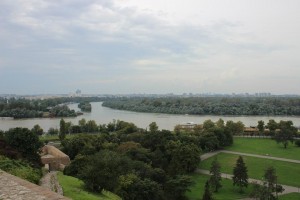
A view of the rivers Sava and Danube where they meet in front of Belgrade’s fortress, Kalemegdan. Photo cred: SIT Balkans
I would like to tell you about Belgrade, but I’m not sure where to begin. Even the most basic facts about this city, including the origin of its name, are up for debate. As a tour guide told us one day, there is one thing we can say for certain: everything here is complicated.
“If something is simple,” she added, “don’t worry–we’ll make it complicated.”
In addition to complicated politics and history, there is also a variety of opinions about these topics. A trivial example of this is the meaning behind “Beograd” (Belgrade). According to one opinion, Beograd–meaning “white city”– got its name from the white stones of the city’s ancient fortress. The next day, I heard a different interpretation when our language teacher insisted that the color white used to be associated with the direction East, meaning Beograd was named such for being an eastern city. In this case, the discrepancy isn’t important, but you can imagine how quickly things become convoluted. If you are a believer in facts, you will hate it here.
That being said, there is still a lot of truth to unveil in the Balkans. In my mind a quote from the author Tim O’Brien keeps echoing: “A lie, sometimes, can be truer than the truth…”. Various memories, interpretations, and fabrications of events make it difficult to discover what actually happens, but after reflecting on all the narratives, it is still possible to understand the significance of what happens here. In other words, while different perspectives in the Balkans are often at odds with one another, it is entirely possible for all of them to be true. Furthermore, these narratives reveal a great deal about human nature and conflict beyond the context of the Balkans.
Belgrade reflects this principle in details as commonplace as street names. Depending on how power changes in the international arena or in the Balkans, the names of significant streets change, too. (For example, a street may be named after someone who is a martyr of one era, but considered a terrorist in the next). Sometimes you can ask several people what street you’re on and they will all give you a different answer. Technically, each answer is correct, since the street has been called all those names; however, the name by which each person calls it indicates how long that person has lived in Belgrade, how in tune they are with current politics (or if they sympathize with the current government), or simply how much they care about something so trivial. By the time you finally make it to your destination, you still won’t know what street you’re on; but, you will know a little bit about its past and the people who walk along it.
*I was unable to upload a relevant picture because my camera died and I need to buy a new charger. My advice to anyone about to travel abroad: double-check that you packed EVERYthing. Like right now.